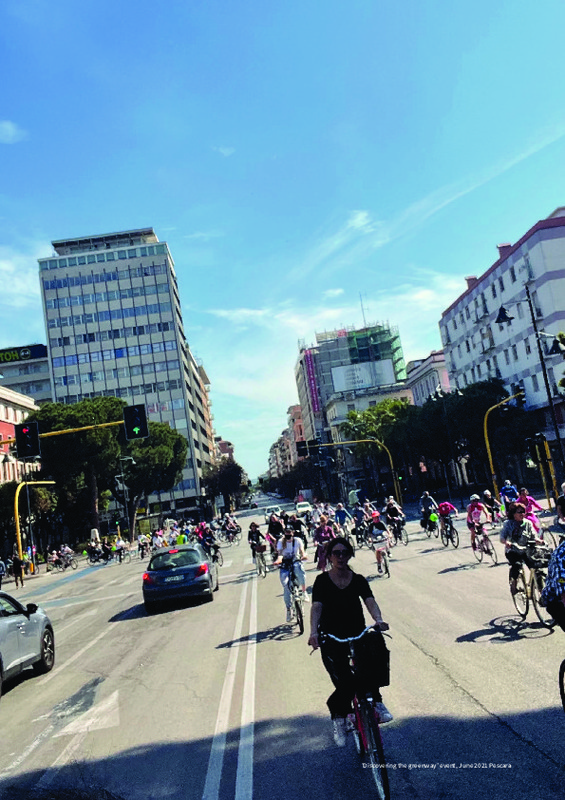JavaScript is disabled for your browser. Some features of this site may not work without it.
Buscar en RiuNet
Listar
Mi cuenta
Estadísticas
Ayuda RiuNet
Admin. UPV
Sustainable mobility and beauty of public space
Mostrar el registro sencillo del ítem
Ficheros en el ítem
| dc.contributor.author | Mastrolonardo, Luciana
|
es_ES |
| dc.date.accessioned | 2022-01-05T08:34:39Z | |
| dc.date.available | 2022-01-05T08:34:39Z | |
| dc.date.issued | 2021-12-31 | |
| dc.identifier.uri | http://hdl.handle.net/10251/179283 | |
| dc.description.abstract | [EN] The quality of built environment is linked to the space in-between buildings and considers its formal, environmental and use values, due to specific needs for care and project re-appropriation. Sustainable mobility, a strategic objective of the European Union, cannot ignore the quality of the public space. The New European Bauhaus draw a new strategical attention to the critical role the quality of spaces plays in building a better world. The definition of space for active mobility as environmental islands, sidewalks, pedestrian areas, cycle paths or green ways, must follow morphological, functional and organizational needs. The beauty of the space starts from a new language of the street, through qualifying the places and avoiding a passive crossing for the transport logic, but satisfying a need that goes beyond our material dimension and is inspired by creativity and culture. This qualification is represented here in the case study of an Italian Biciplan as a sector plan able to build inclusive and accessible physical spaces for the community. The lack of attention of technicians in the execution of public works leads to reconsider the importance of these issues also in education and training. The fragmentation of technological knowledge must be recalibrated to provide useful tools without forgetting the quality and the overall beauty of the places when street language improve, also for cultural reason. | es_ES |
| dc.language | Inglés | es_ES |
| dc.publisher | Universitat Politècnica de València | es_ES |
| dc.relation.ispartof | VITRUVIO - International Journal of Architectural Technology and Sustainability | es_ES |
| dc.rights | Reconocimiento - No comercial (by-nc) | es_ES |
| dc.subject | Sustainable mobility | es_ES |
| dc.subject | Public space | es_ES |
| dc.subject | Urban beauty | es_ES |
| dc.subject | Urban quality | es_ES |
| dc.subject | Urban regeneration | es_ES |
| dc.subject | Accessibility | es_ES |
| dc.title | Sustainable mobility and beauty of public space | es_ES |
| dc.type | Artículo | es_ES |
| dc.identifier.doi | 10.4995/vitruvio-ijats.2021.16560 | |
| dc.rights.accessRights | Abierto | es_ES |
| dc.description.bibliographicCitation | Mastrolonardo, L. (2021). Sustainable mobility and beauty of public space. VITRUVIO - International Journal of Architectural Technology and Sustainability. 6(2):42-55. https://doi.org/10.4995/vitruvio-ijats.2021.16560 | es_ES |
| dc.description.accrualMethod | OJS | es_ES |
| dc.relation.publisherversion | https://doi.org/10.4995/vitruvio-ijats.2021.16560 | es_ES |
| dc.description.upvformatpinicio | 42 | es_ES |
| dc.description.upvformatpfin | 55 | es_ES |
| dc.type.version | info:eu-repo/semantics/publishedVersion | es_ES |
| dc.description.volume | 6 | es_ES |
| dc.description.issue | 2 | es_ES |
| dc.identifier.eissn | 2444-9091 | |
| dc.relation.pasarela | OJS\16560 | es_ES |
| dc.description.references | Asperges, T. 2008. Cycling, the European approach. Total quality management in cycling policy and lessons learned of the BYPAD-project. EACI-STEER programme. | es_ES |
| dc.description.references | Bernhoft, I.M., & Carstensen, G. 2008. Preferences and behaviour of pedestrians and cyclists by age and gender. In: Transportation Research, Part F, Vol. 11, pp. 83-95. Elsevier. https://doi.org/10.1016/j.trf.2007.08.004 | es_ES |
| dc.description.references | Giuliani F., Maternini G.2018. Mobilità ciclistica e sicurezza. Egaf edizioni Forlì. | es_ES |
| dc.description.references | Krizek, K.J. & Johnson, P.J. 2006. Proximity to Trails and Retail: Effects on Urban Cycling and Walking. Journal of the American Planning Association, 72(1), pp. 33-42. Chicago, USA: American Planning Association. https://doi.org/10.1080/01944360608976722 | es_ES |
| dc.description.references | Mastrolonardo, L., & Romano, M. 2016. The environmental project of the enhancement of the fluvial area: L'Aquila and the Aterno River. TECHNE - Journal of Technology for Architecture and Environment, (11), 143-150. doi.org/10.13128/Techne-18414 | es_ES |
| dc.description.references | Mussinelli, E. 2018. Il progetto ambientale dello spazio pubblico, Eco-WebTown, Journal of Sustainable Design, Vol. 2, n. 18. | es_ES |
| dc.description.references | Pucher, J., & Dijkstra. 2003. Promoting Safe Walking and Cycling to Improve Public Health: Lessons from The Netherlands and Germany. American Journal of Public Health, 93, pp. 1509-1516. American Public Health Association. https://doi.org/10.2105/AJPH.93.9.1509 | es_ES |
| dc.description.references | Sacco, P.L., & Ferilli, G., Lavanga M. 2006. The cultural district organizational model: a theoretical and policy design approach. Mimeo, DADI, Università IUAV. | es_ES |








